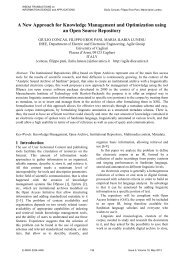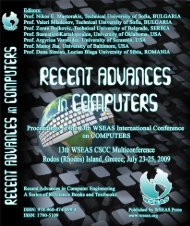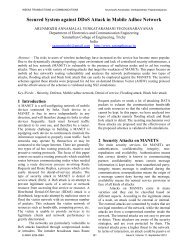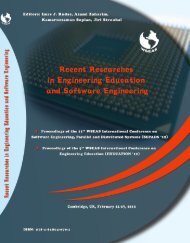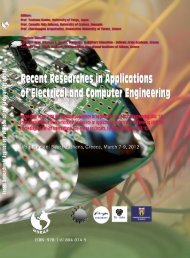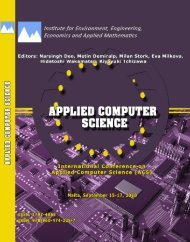Heuristic Search Method for Digital IIR Filter Design - WSEAS
Heuristic Search Method for Digital IIR Filter Design - WSEAS
Heuristic Search Method for Digital IIR Filter Design - WSEAS
You also want an ePaper? Increase the reach of your titles
YUMPU automatically turns print PDFs into web optimized ePapers that Google loves.
<strong>WSEAS</strong> TRANSACTIONS on SIGNAL PROCESSING<br />
Ranjit Kaur, Manjeet Singh Patterh,<br />
J. S. Dhillon, Damanpreet Singh<br />
1,<br />
<strong>for</strong> i<br />
passband<br />
H<br />
d<br />
( i<br />
) <br />
(6)<br />
0,<br />
<strong>for</strong> i<br />
stopband<br />
The ripple magnitudes are to be minimized of passband<br />
and stop-band, which are denoted by<br />
( ) and ( ) respectively. Ripple magnitudes are<br />
1 x<br />
2 x<br />
defined as:<br />
x)<br />
max H(<br />
, x)<br />
min H(<br />
, x)<br />
<br />
1(<br />
i<br />
i<br />
i<br />
i<br />
(7)<br />
<strong>for</strong>i<br />
passband<br />
and<br />
<br />
2(<br />
x)<br />
maxH<br />
( i,<br />
x)<br />
<strong>for</strong> i<br />
stopband (8)<br />
i<br />
Aggregating all objectives and stability constraints,<br />
the multi-criterion constrained optimization problem<br />
is stated as:<br />
Minimize f x)<br />
e ( )<br />
1( 1<br />
x<br />
2( x)<br />
e2<br />
( x<br />
3( x)<br />
1(<br />
x<br />
4( x)<br />
<br />
2(<br />
x<br />
Minimize f )<br />
Minimize f )<br />
Minimize f )<br />
(9a)<br />
Subject to: the stability constraints:<br />
1 q1 i<br />
0 ( i 1,2,....,<br />
M)<br />
(9b)<br />
1 q1 i<br />
0 ( i 1,2,....,<br />
M)<br />
(9c)<br />
1 s2 k<br />
0 ( k 1,2,....,<br />
N)<br />
(9d)<br />
1 s1 k<br />
s2k<br />
0 ( k 1,2,....,<br />
N)<br />
(9e)<br />
1 s1 k<br />
s2k<br />
0 ( k 1,2,....,<br />
N)<br />
(9f)<br />
The multiple-criterion constrained optimization<br />
problem <strong>for</strong> the design of digital <strong>IIR</strong> filter is<br />
converted into a scalar constrained optimization<br />
problem by using a weighted sum of the objectives<br />
to generate non-inferior solutions.<br />
<br />
L<br />
<br />
<br />
p<br />
p<br />
Minimize f ( x)<br />
<br />
wj f<br />
j<br />
( x)<br />
<br />
(10)<br />
j1<br />
<br />
such that(1 p )<br />
Subject to: The satisfaction of stability constraints<br />
given by Eq. (9b) to Eq. (9f).<br />
Where f j<br />
(x)<br />
is the j th objective function, and w is<br />
j<br />
non-negative real number called weight assigned to<br />
j th objective. This approach yields meaningful<br />
results when solved many times <strong>for</strong> different values<br />
of w<br />
j<br />
, (j = 1, 2,..., L). The p-norm weighting<br />
patterns are either presumed on the basis of decision<br />
maker’s intuition or simulated with suitable step<br />
size variation. A problem with the weighted sum<br />
technique arises when the lower boundary of<br />
function space is not convex [27], because not every<br />
non-inferior solution will have a supporting hyperplane.<br />
In case, the non-inferior surface is nonconvex<br />
the weighted sum method may yield poor<br />
<br />
1<br />
designs no matter what weight or optimization<br />
technique is used. The paper presents a systematic<br />
weight selection heuristics using Evolutionary<br />
search technique. The weight selection techniques<br />
used in a digital filter design have been discussed by<br />
Cortelazzo and Lightner [27]. The design of causal<br />
recursive filters requires the inclusion of stability<br />
constraints. There<strong>for</strong>e, the stability constraints given<br />
by Eq. (9b) to Eq. (9f) which are obtained by using<br />
the Jury method [28] on the coefficients of the<br />
digital <strong>IIR</strong> filter in Eq. (3) are included in the<br />
optimization process. Scalar constrained<br />
optimization problem is converted into<br />
unconstrained multivariable optimization problem<br />
using penalty method. Augmented function is<br />
defined as in Eq. 10 with p=1 is defined as:<br />
A(<br />
x)<br />
<br />
where<br />
c <br />
d <br />
M<br />
<br />
i1<br />
N<br />
<br />
k1<br />
L<br />
<br />
j1<br />
1<br />
q<br />
w f ( x)<br />
r c d<br />
j<br />
1i<br />
1<br />
s<br />
1k<br />
j<br />
2<br />
<br />
s<br />
M<br />
<br />
i1<br />
2k<br />
2<br />
<br />
1<br />
q<br />
<br />
N<br />
<br />
1i<br />
k1<br />
<br />
2<br />
<br />
1<br />
s<br />
N<br />
<br />
k1<br />
1k<br />
1<br />
s<br />
s<br />
2k<br />
2k<br />
2<br />
2<br />
(11)<br />
r is a penalty parameter having large value. Bracket<br />
function <strong>for</strong> constraint given by Eq. (9b) is stated<br />
below:<br />
<br />
1<br />
q1<br />
i<br />
if 1<br />
q1<br />
i<br />
0<br />
1<br />
q<br />
1i<br />
<br />
(12)<br />
0<br />
if (1 q1<br />
i<br />
) 0<br />
Similarly bracket functions <strong>for</strong> other constraints<br />
given by Eq. (9c) to Eq. (9f) are undertaken.<br />
3 <strong>Heuristic</strong> <strong>Search</strong> Approach <strong>for</strong> the<br />
<strong>Design</strong> of <strong>IIR</strong> <strong>Filter</strong><br />
A heuristic search is used to describe a sequential<br />
examination of trial solutions. The procedure of<br />
going from a given point to the next improved point<br />
is called a ‘move’. A move is termed a ‘success’ if<br />
the objective improves; otherwise, it is a ‘failure’.<br />
The heuristic search routine makes four types of<br />
moves. The first move is random initialization.<br />
Random initialization has been framed to acquire<br />
best starting point. The second move is exploratory<br />
move designed to acquire knowledge concerning the<br />
behavior of the function. This move is per<strong>for</strong>med in<br />
the vicinity of the current point systematically to<br />
find the best point around the current point. The<br />
third move is a pattern move with random<br />
acceleration factor. Weight Pattern search based on<br />
evolutionary search method is applied to search the<br />
normalized weights, w ( i 12 , ,...,L)<br />
assigned to<br />
i<br />
<br />
E-ISSN: 2224-3488 124 Issue 3, Volume 8, July 2012




